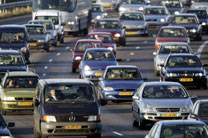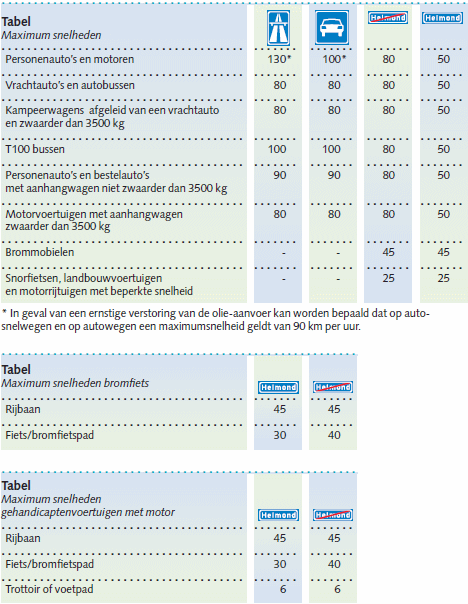Source: infopolitie.co.uk
art. 19: Keeping distance
The driver must be able to stop the vehicle within the distance over which he can overlook the road and over which it is clear.
 By this, of course, is meant tailgating. A large proportion of collisions are due to the violation of this rule. People drive too close together. A good rule of thumb is half the speed driven, but in meters.
By this, of course, is meant tailgating. A large proportion of collisions are due to the violation of this rule. People drive too close together. A good rule of thumb is half the speed driven, but in meters.
In other words, at 90 km/h, the distance between them must be at least 45 meters. Assuming a reaction time of 1 second, a driver at 90 km/h already needs 25 meters before he has his foot on the brake pedal.
Therefore, if a car drives within that distance behind the car in front, a collision is inevitable in the event of any emergency braking by the car in front.
art. 20: Inside built-up area
The following speed limits apply within built-up areas:
- For motor vehicles: 50 km/h
- For mopeds and disabled vehicles equipped with an engine:
1. on the bicycle path or bicycle/moped path 30 km per hour;
2. on the roadway 45 km per hour; - for disabled vehicles, equipped with an engine, on the sidewalk or footpath 6 km per hour.
Different speeds may be indicated by signs. For example, in 30 km/h areas or on entrance and exit roads of freeways or on ring roads etc.
art. 21: Outside built-up area
Outside built-up areas, the following speed limits apply:
- Motor vehicles on freeways: 120 km/h.
- Motor vehicles on highways: 100 km/h
- Motor vehicles on other roads: 80 km/h
- Mopeds and disabled vehicles equipped with an engine:
1. on the bicycle path or bicycle/moped path 40 km per hour;
2. on the roadway 45 km per hour; - Disabled vehicles, equipped with a motor, on the sidewalk or footpath 6 km per hour.
Articles 20 and 21 RVV 1990 regulate the maximum speed of mopeds. Previously, the moped speed limit was 30 km per hour inside built-up areas and 40 km per hour outside. The immediate reason for the change in the moped speed regime was that for some time now, mopeds have had to ride on the carriageway instead of the bike path on most lanes within built-up areas.
Increasing the speed limit for mopeds on the roadway to 45 km per hour has reduced the speed differences between mopeds and car traffic on the roadway both inside and outside built-up areas, thus improving safety and traffic flow.
Moped riders who are better able to keep up with car traffic on the roadway ride more among cars than to their right, resulting in fewer collisions between right-turning cars and straight-through moped riders.
The same obviously plays out on roads without bike lanes. Where a lower general speed limit applies (for example, in 30-km areas), this limit obviously applies to the moped as well.
The speed limit of 45 km per hour on the roadway is equal to the construction speed of the moped and also equal to the speed limit already in place for mopeds. The maximum speed of the moped on the bicycle/moped path is 30 km per hour within the built-up area and 40 km per hour outside the built-up area.
This makes it clear that where the moped is in the area ideally intended for slow traffic, an increase in the speed limit was not an issue for reasons of road safety. The maximum speed of disabled vehicles on the carriageway, which have the same speed regime as mopeds in the RVV 1990, has been similarly modified.
Article 7 RVV 1990 allows drivers of a disabled vehicle to use the sidewalk and footpath. Drivers of a disabled vehicle, which is equipped with a motor, can thereby reach speeds that far exceed those of pedestrians.
This can easily create situations on the sidewalk and sidewalk that can lead to injury, especially for pedestrians. Because this is undesirable from a road safety perspective, pursuant to the added part c in Article 20 RVV 1990, drivers of a disabled vehicle equipped with and engine may not drive faster than 6 km per hour on the sidewalk and sidewalk. That speed corresponds to the average speed of a pedestrian.
Speeds shown on matrix signs are no longer advisory speeds, but indicate the maximum speed to be driven.
art. 22: Other speeds
- To the extent that a lower speed limit does not apply pursuant to other articles, the following vehicles are subject to the following special speed limits:
- For campers referred to in Article 1.1. of the Vehicle Regulations and whose authorized maximum mass exceeds 3500 kg, trucks and buses, other than T100 buses 80 km per hour;
- For motor vehicles with trailers, 80 km per hour;
- for agricultural or forestry tractors and motor vehicles with limited speed, as referred to in Article 1.1 of the Vehicle Regulations 25 km per hour;
- For mopeds 45 km per hour;
- For mopeds 25 km per hour.
- Contrary to subsection 1(b), a maximum speed of 90 km per hour shall apply to motor vehicles other than those referred to in subsection 1(a) and (c), which are propelling a trailer with an authorized maximum mass not exceeding 3,500 kg on freeways and expressways.
The speed limit for tractors was always 16 km/h; now they are allowed 25 km/h. As of May 1, 2009, vehicles with a light trailer (less than 3500 kilograms) and light camping trailers (under 3500 kilograms) are allowed 90 km/h on motorways and highways.
Article 22a: T100 bus
Unless a lower speed limit applies pursuant to other articles, T100 buses are subject to a speed limit of 100 kilometers per hour.
In practice, it was found that there was ambiguity regarding the speed limit of T100 buses on highways. By amending Article 22, part a, RVV 1990 in conjunction with Article 22a RVV 1990, it has been clarified that the maximum speed of T100 buses on highways is the same as that on freeways, namely 100 km per hour.
Summary:
